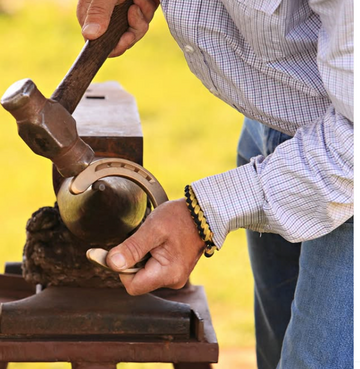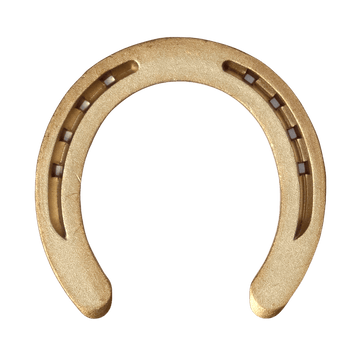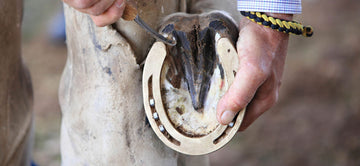Why Horse Owners Are Choosing Copper Horseshoes
When it comes to protecting your horse’s hooves, not all shoes are created equal. The horse owner plays a crucial role in making informed hoof care decisions to ensure the long-term health of the horse's foot. Traditional horseshoe nails, commonly used in steel shoes, offer support and protection but lack antibacterial properties.
They don’t address one of the biggest threats to hoof health—bacteria and fungi that thrive in the damp, organic environments horses live in. Over time, these microorganisms contribute to conditions like thrush, white line disease, and seedy toe, which can lead to lameness and costly treatments.
Bacterial migration through nail holes can compromise the wall surrounding the hoof, leading to hoof damage, increased shearing stress, and bacterial migration proximally, which negatively impacts nail hole health and may result in deeper infections.
While wild and feral horses often maintain healthy hooves naturally due to constant movement and environmental wear, domestic horses may require additional protection and regular farrier care to maintain the health and durability of their feet.
More horse owners are now turning to copper alloy horseshoes because of their unique ability to not only support and protect, but also provide powerful antimicrobial benefits.
Copper is recognized as an antibacterial agent, and its antimicrobial effects and antibacterial qualities have recently gained mainstream support and mainstream support in both veterinary and medical fields. Copper-coated and copper-alloy horseshoe nails are alternatives to steel nails, offering antimicrobial benefits that help reduce bacterial migration and infection risk. Copper sulfate is also used as a topical treatment for hoof infections.
The benefits of copper horseshoes, particularly Kawell USA’s patented Copper Alloy Horseshoes, go far beyond simple protection. They actively promote hoof wellness while reducing the risks of common infections.

How Copper Horseshoes Differ from Steel
Steel horseshoes have been the industry standard for generations, but they do little to prevent microbial growth. Horses that spend time in wet or soiled bedding, or on wood shavings and straw, are constantly exposed to bacteria and fungi that can invade the hoof wall and frog, especially through the ground bearing surface. This can negatively impact horn quality and overall hoof health.
Kawell USA’s Copper Alloy Horseshoes change that dynamic entirely. Made from a patented copper alloy (UNS Alloy No. C6915, EPA Registration #82012-3), these shoes kill 99% of bacteria and fungi on contact due to the antimicrobial effects of copper. The high thermal conductivity of copper makes these horseshoes especially suitable for shaping and forging. Copper alloy horseshoes offer superior wear resistance and corrosion resistance compared to traditional steel and aluminum shoes, helping to prevent excessive wear and maintain horn quality.
When copper interacts with other metals, such as steel nails, a galvanic reaction can occur, further enhancing the antimicrobial effects and helping to kill bacteria at the hoof. Unlike coatings or temporary treatments, the antimicrobial properties of copper don’t wear off, even with repeated exposure to water, abrasion, and environmental contaminants. Copper on the ground bearing surface helps protect the hoof from bacterial entry and supports hoof wall integrity.
Hoof Anatomy and Health
A horse’s hoof is a remarkable structure, designed to support the animal’s weight and withstand the rigors of daily activity. The hoof wall, made of tough, keratin-rich material, acts as the first line of defense against environmental hazards and provides essential support to the horse’s foot. Beneath the wall lies the sole, which protects the sensitive inner structures, while the frog—a V-shaped, rubbery section—helps absorb shock and distribute pressure with every step.
Maintaining optimal hoof health is crucial for a horse’s comfort and performance. Issues like white line disease, seedy toe, and cracks in the hoof wall can cause pain, lameness, and long-term damage if left untreated. Regular trimming and shoeing by a skilled farrier are essential to lessen these problems and keep the hoof in top condition.
Copper alloy horseshoes and copper coated steel nails offer an added layer of protection for the hoof wall. Thanks to their antimicrobial properties, these products help reduce the risk of bacterial invasion and support healthy hoof growth. By integrating copper alloy horseshoes and copper coated steel nails into your horse’s shoeing routine, you can help safeguard against common hoof problems and promote lasting hoof health.
The Health Benefits of Copper Horseshoes
Switching to copper horseshoes brings a host of advantages for both horse and owner. These benefits include:
-
Antimicrobial Protection: Copper salts naturally inhibit bacterial and fungal growth, drastically reducing the risk of thrush and white line disease. Studies by Sunshine Coast Podiatry Services and John Wilson have demonstrated that copper horseshoes and copper coated horseshoe nails provide significant antimicrobial benefits, especially over two shoeing cycles and multiple shoeing cycles.
-
Improved Hoof Health: By minimizing microbial damage, hooves remain stronger, more resilient, and less prone to cracks and deterioration. Improved nail hole health is a specific benefit, as copper nails and copper horseshoe nails help maintain the integrity of the hoof tissue surrounding the nails and prevent bacterial migration proximally through the hoof wall.
-
Reduced Impact Stress: Kawell USA’s copper alloy shoes absorb 8.53% of impact energy per step, lowering stress on joints and ligaments.
-
Long-Lasting Performance: Copper’s antimicrobial properties remain active for the life of the shoe, unlike chemical treatments that wear away. The benefits have been observed consistently across shoeing cycles.
-
Environmental Responsibility: These shoes are 100% recyclable, aligning with eco-friendly practices.
-
Lower Long-Term Costs: By reducing infections and the need for repeated treatments, copper horseshoes save money over time. Copper sulfate can also be used as a complementary topical treatment to further prevent pathogen invasion.
Copper’s use in hoof care has recently gained mainstream support and mainstream support in veterinary medicine, with copper coated nails and copper alloy horseshoe nails now recognized as part of an effective copper hoof care system.
For horses in training, competition, or challenging environments, these benefits translate to improved comfort, fewer soundness issues, and more consistent performance.
Combining Copper Horseshoes with Other Kawell Hoof Products
For the best results, copper alloy horseshoes should be part of a broader hoof care strategy. Pairing them with Kawell USA’s Natural Horse Hoof Paste, Copper Alloy Frog Inserts, and topical treatments like copper sulfate enhances their protective and restorative benefits.
Incorporating copper coated nails and copper alloy horseshoe nails as part of this comprehensive hoof care system further supports hoof health by providing additional antimicrobial effects. Using these products together can improve horn quality, strengthen hoof integrity, and help prevent bacterial invasion.
Natural Horse Hoof Paste
This nutrient-rich horse hoof paste nourishes and conditions the hoof. It maintains optimal moisture balance, supports growth, and further protects against bacterial and fungal infections. For enhanced antimicrobial effects, copper sulfate can be used in conjunction with the paste to help prevent pathogen invasion and support hoof health. Daily application after cleaning can significantly improve overall hoof resilience.
Copper Alloy Frog Inserts
For horses prone to thrush or with deep collateral sulci, Kawell USA’s Copper Alloy Frog Inserts provide targeted antimicrobial action in the areas most vulnerable to infection. The antimicrobial effects of the copper alloy help reduce bacterial invasion and microbial damage, supporting overall hoof health by lowering infection risks associated with horseshoe nails. Developed by Esco Buff, PhD, APF-I, CF, these patented inserts are a valuable tool for preventing recurring frog issues.
Copper Alloy Bar Stock
For horses requiring custom shoeing solutions, farriers can use Kawell’s copper alloy bar stock to fabricate specialized designs that retain the same antimicrobial and shock-absorbing properties as our standard shoes.
Why Copper Horseshoes Save Money and Time
While copper alloy horseshoes cost more upfront than steel, they quickly prove their value by reducing veterinary and farrier expenses. Thrush and white line disease can lead to costly treatments, missed training days, and long recovery times. By eliminating the microbial conditions that cause these problems, copper shoes prevent these disruptions before they start.
Owners also save time. With less risk of infections, there’s no need for constant topical treatments or repeated hoof soaks. Combined with routine cleaning and conditioning, copper alloy shoes streamline hoof care.
Frequently Asked Questions
Do copper horseshoes prevent thrush completely?
While no horseshoe can completely eliminate thrush risk, copper alloy shoes kill the bacteria and fungi that cause the infection. The antimicrobial effects of copper help kill bacteria responsible for thrush, reducing the risk of infection. Combined with good cleaning habits and frog inserts for high-risk horses, they can prevent most cases.
Will copper horseshoes tarnish over time?
Yes, copper tarnishes naturally, but this doesn’t reduce its effectiveness. Tarnishing actually enhances antimicrobial activity by producing copper salts that inhibit microbes.
Are copper horseshoes heavier than steel shoes?
Kawell USA’s copper alloy shoes are similar in weight to steel shoes, so they won’t impact performance or movement. Their impact absorption properties even make them easier on joints and tendons during work.
How long do copper horseshoes last?
They typically last as long as steel shoes and need resetting every four to six weeks. Their antimicrobial benefits remain active for the entire life of the shoe.
Are copper horseshoes safe for all horse types?
Yes. Kawell USA’s Copper Alloy Horseshoes are EPA-approved and safe for all breeds and disciplines, including performance horses, those prone to hoof infections, and horses in wet environments.
Conclusion
The benefits of copper alloy horseshoes extend far beyond simple protection. With Kawell USA’s Copper Alloy Horseshoes, you’re not just guarding against mechanical wear—you’re actively improving hoof health by neutralizing harmful microbes, reducing impact stress, and preventing costly infections.
When paired with products like Natural Horse Hoof Paste and Copper Alloy Frog Inserts, copper shoes create a comprehensive hoof care system that keeps your horse sound, comfortable, and ready for any challenge.
By choosing copper alloy, you’re investing in a long-term solution that saves time, money, and stress while giving your horse the healthiest hooves possible.










